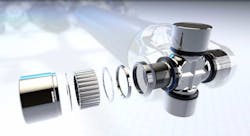The role of the driveline is to transmit torque from the engine transmission to the rear axle, and ultimately the wheels, in the most efficient and reliable way possible. The role of a fleet manager is ensure proper vehicle maintenance in order to maximize uptime. Both are a critical links to moving a vehicle down the road, and a failure in either system could render a truck immovable, resulting in numerous expenses and loss of revenue.
That's why proper driveline preventive maintenance inspection is imperative, says Meritor's Product Technical Specialist Eric Iott. Meritor (www.meritor.com) is a global supplier of axle, brake and suspension solutions to OE manufacturers and the aftermarket.
"A driveline failure can cause more than $1,000 to replace the unit, plus additional costs to repair the chassis damage that potentially occurred with the driveline failure," Iott says.
A failure in these systems could result in downtime for typically three to seven days, according to Iott.
He says expenses resulting from a driveline failure could include:
Vehicle tow
Driveline replacement
Labor to install
Lost revenue
Repairing wiring harnesses, air lines, cross members and other components on the chassis
"Simple inspection and periodic maintenance can save thousands of dollars of unnecessary expense," Iott says.
Inspection Recommendations
While the driveline is designed for the life of a truck, due to harsh environments and often severe duty cycles, there are instances where drivelines need to be serviced and worn components replaced, says Tom Bosler, Dana Inc.'s director of global product planning for the commercial-vehicle market. Dana (www.dana.com) is a supplier of drivetrain, sealing, and thermal-management technologies.
"It is imperative to follow inspection procedures to check splines and joints for possible looseness or dented tubes," Bosler says. "Proper lubrication at recommended maintenance intervals is another key factor in maximizing the longevity of driveline components."
Consider the following recommendations when inspecting the drivelines, according to Meritor's Iott:
Use Proper Lighting During Inspection. Use a bright light to see the full picture and find more potential problems earlier and prevent more severe failures.
Check for Movement in the U-joint Prior to Greasing. The movement allotments are determined by the manufacturer. For example, in Meritor's Xtended Lube MXL and Permalube RPL Series U-joints movement should not exceed .006 inch in any direction.
Check Center Bearings. These may require replacement if there is excessive movement between the rubber bushing and the mounting bracket, or any movement in the bearing assembly itself. For example, Iott says to follow these guidelines during inspection:
- Slip Yoke: Movement at the slip spines should not exceed .017 inch
- End yoke: Any movement on the end yoke splines will require replacing with a new yoke, nut and U-joint mounting straps.
"Re-tightening this connection rarely works and the problem typically recurs," Iott says.
- U-joint mounting hardware: Any loose mounting hardware or straps should be replaced with new parts.
U-joint Greasing. Always check the driveline system prior to any greasing of a component.
"Go old school... more is better in this situation," Iott says. "Continue pumping grease into the U-joint until you see clean grease purging from all four journal caps. A major U-joint failure mode is associated with a technician’s failure to purge all four trunnion caps."
Slip Yoke Greasing. Purge grease and water from the slip yoke seal until clean grease appears from the seal. Moisture ingestion is a big problem, Iott says, in the slip joint assembly.
Driveshaft Phasing. Proper end yoke or slip yoke phasing is required on a driveshaft to eliminate driveline vibration. An “In Phase” driveshaft has the ears of the yoke in alignment. An “Out of Phase” driveshaft has the ear of the yoke out of alignment by 90 degrees or more.
"Because either situation may be correct, technicians must contact the OEM to determine correct phasing requirements for a specific year and model truck," Iott recommends.
Spec'ing Correct Components. It’s important to specify the right components for your vehicle, especially if you are choosing a system designed for engine downspeeding, Dana's Bosler says.
"An engine running at lower rpms places significantly higher torque stresses in the driveline system and improper spec’ing can lead to premature and extended maintenance needs," Bosler says.
Downspeeding is a new truck drivetrain configuration that increases fuel efficiency, but it has an effect on the driveline torque, Meritor's Iott explains.
"This spec configuration increases the driveline torque and the increased torque can have an impact on driveline as a potential overload situation if the driver puts the truck into wrong place at the right time," he says.
Common Mistakes or Oversights
The lack of attention to detail in the inspection process is a leading cause of failures, Meritor's Iott says.
Common oversights occur in:
Loose Fasteners: Technicians will overlook loose fasteners at the center bearing mounting and loose end yoke nuts at the major components, such as axles, transmissions and center bearings. Checking for vertical or rotational movement at these locations can prevent failures later in the driveline’s life, Iott says.
Slip Yoke Shaft: "Checking for slip yoke spline wear is simple and easy, moving the shaft up and down to gauge the amount of movement," Iott says. "This check is commonly overlooked by technicians."
Greaseable U-joint Purging: As previously mentioned, technicians commonly overlook purging all four journal caps during the planned maintenance greasing period. Grease must purge all four positions for proper U-joint life. This is the most common preventable maintenance U-joint failure.
Furthermore, the use of standard chassis grease can break down and become ineffective, negatively impacting performance, Dana's Bosler explains. Instead of this, Bosler recommends using a synthetic grease specifically formulated for universal joints. For example, Dana offers the SPL Series product line.
Bigger Picture. PACCAR Parts' Product Director Pepe Ramos says a common oversight is "not looking beyond the damaged components to potential down-line or up-line issues."
PACCAR Parts (www.paccarparts.com), a division of PACCAR, Inc., is a global distributor of aftermarket parts for heavy and medium duty trucks, trailers, buses and engines.
Warning Signs for Technicians
While vibration often occurs in trucks, and there can be many contributing factors to the source of it, explains Dana's Bosler.
"When it comes to the driveline, balance issues along with excessive looseness in universal joints or slip splines are key indicators that parts are worn," Bosler says.
Balance is an important part of the driveline because its components are not in a straight line. Each driveshaft’s U-joints allow different segments of the driveline to operate in different planes or at different angles to transfer torque and rotation to the rear axles, explains Meritor's Iott. These planes (or operating angles) can change dynamically as a suspension moves up and down during vehicle operation. Specific design rules must be followed during chassis design to ensure the driveline angles work together to cancel vibrations created by the U-joint’s cardan U-joint design.
So, when balance issues occur there can be excess vibration or squeaking noises.
Warning signs for technicians of a potential driveline failure are as follows:
Excessive movement in the U-joint
U-joint caps or straps fasteners are loose
Movement in the center bearing mounting or bearing
Excessive movement in a slip yoke spline
Fasteners that show signs of “fretting corrosion” on the matting surfaces are loose fasteners
U-joint journals that do not purge grease
Slip yoke seal that has popped loose of the slip yoke
Dents or bent driveline tube
Missing weld balance weights
There are also warning signs for drivers, which can signal potentional driveline failure. (See "Warning Signs for Drivers of Driveline Failure" sidebar on page XX). .
Proper Maintenance
"The Benjamin Franklin axiom that, 'an ounce of prevention is worth a pound of cure,' can be applied to the driveline," Dana's Bosler says. "Proper inspection and maintenance can be the difference between making deliveries on time and having expensive repairs in the field."
About the Author
Vesna Brajkovic
Associate Editor - Vehicle Repair Group
Vesna Brajkovic is a former associate editor for the Vehicle Repair Group.
Brajkovic has covered the transportation industry for a number of trade publications, with a focus on the vehicle maintenance and automotive aftermarket industries since 2016. Prior to that, she covered the global aviation industry as assistant editor for Endeavor Business Media's AviationPros.com, and held a number of editorial positions at an award-winning community newspaper.

